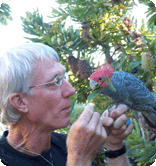Breeding parrots and parakeets in a mixed species aviary

Dear EB, My aviary is in 6 sections all open. It measures 35 metres. The 17 parakeets use all the space. The parrots less so.
I have 2 pairs of rescue small birds - Plumheaded parakeets, a male aged 4 and a female 1, and Kakarikis both one years old. If they try want to breed next year will I have to separate them from the others. If so which month? The Rock Pebbler Parakeets that are housed there have bred twice with no problems.
Thank you.
Regards, Dot in UK

Dear Dot, ‘Tis not easy to flatly answer your question as I do not know the birds personally and observation usually tells whether certain pairs in a mixed colony will disrupt breeding of themselves or other pairs.
That said, the species in question have been colony bred by others in the past (Kakarikis less so…) and are basically decent candidates for success in your large spaces.
The rule is usually offer two or more extra nest boxes beyond your number of pairs to lessen fighting over spots. If several pairs all want the same box, just take it down and put it elsewhere or exchange it for a different one.
If you are very careful about the entrance holes for each of the boxes, you can eliminate the larger parrots from getting inside the smaller openings. Some Kakarikis prefer tight entrances or tube-like passages to a box.
Food dishes too, should be non-competitive and extra for the number of pairs or else the greedier birds will fly from one to another getting all the best and fattiest foods.
Once compatibility is established and the birds feed without aggressive competition, the most dangerous time is when new peeps are heard in a box. Other more curious and excitable birds could enter the newly hatched clutch site and endanger babies. You will have to be diligent in watching out for same.
Of course, actual production of babies is not always the goal in such situations; more so, is the enjoyment the pairs get of copulating, inter-feeding, laying, hatching and such over the weeks of the season, so I would say, give it a try and keep notes. It will certainly teach you a lot about your pairs, and may make the content for a future magazine article.
Cheers, EB

































